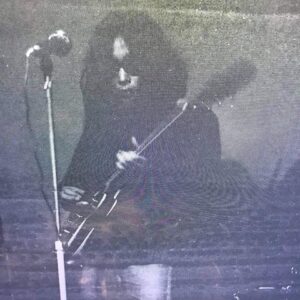When it was decided to close OZ, manager Minoru Tezuka resolved to preserve OZ’s legacy by leaving behind a compilation record of the bands that played there.
Minoru Tezuka: Right around that time, the movie “Fillmore: The Last Days” was released. When Bill Graham closed Fillmore West, he made a movie out of the last show at the club. That inspired me, and I thought to myself, “I’ll do the same thing – I can’t make a movie, but I’ll make a record.” It became a double album compiling the performances of the five bands that had played at OZ, and was called “OZ DAYS LIVE.”
The Rallizes sound was recorded without audience. The drummer was Shoda, the rhythm guitar was Nakamura, and the bass at that time was Nagata, but on that day it was Kubota.
We didn’t have money and the equipment was rough; we had a cheap Sony microphone and a TEAC or that kind of tape recorder, something like 6 or 8 channels, plugged directly into a Yamaha box-type amp, and recorded like that. Doronco, Kiyohiro Takada, was in charge of the recording. He did everything, from the set-up to everything else.
Doronco: I couldn’t do the “OZ DAYS LIVE” engineering by myself so, like at Musashino Public Hall, I asked my friend from high school to help me. The two thin microphones we used for vocals at Musashino Public Hall were condenser mics brought by that same friend, and they had great sound. He later became one of the leading PA engineers in Japan, working at places like Budokan and Tokyo Dome. He has his own PA company, I think he’s chairman now. I would guess it was probably his work together with me on the Rallizes sound engineering that spurred him on that path.
These days microphones are amazingly cheap. Even for home recording, everyone buys and uses good microphones. But at that time, microphones were crazy expensive, and a Shure 58, which these days is widely used everywhere, cost 72,000 yen in those days. In any case, it was out of reach. So how did we record? Just around that time, Sony introduced the first ECM microphone, a type of condenser mic that runs on a single battery in the body. The lower-priced model was, I think, 2,500 yen each, and I bought around three of them. Aside from that, the OZ venue was a former singing cafe, and a lot of its remains were still scattered around. There were broken microphones lying around here and there, and I repaired them. I think I used them to record the bass drum sound.
(listening to “OZ DAYS LIVE”) This stereo sound is amazing. I put one microphone on each instrument, and mixed the sound, but without any monitor, it was all by intuition. It came out really well I think.
Shigeo Matsumoto, who would later coordinate and hold the Les Rallizes Dénudés concert at the Maison franco-japonaise, was one of the people who witnessed the Rallizes performance at OZ and became fascinated with them.
Shigeo Matsumoto (graphic designer): In 1970 or 1971, I met Shunichiro Shoda at art prep school. He was in oil painting, and I was in design. Shoda had already started playing drums with Rallizes, and on performance days, practice days, etc, there was something different about him, a kind of tension around him that made him unapproachable. It was through this connection that I started going to Rallizes live shows.
When I saw them in OZ, Mizutani was singing right in front of my eyes, just a few meters in front of me. At that time, the stage action was pretty intense, and he was shouting as if wringing it out from his body. I could also catch the words perfectly clearly. I think he was only using fuzz on his guitar, but it was enough. Mizutani’s guitar pulled the sound up to its utmost limits. Then suddenly it would drop. That totally blew me away. I was still a student, and went to see a show with a girl from my class. It was the kind of feeling like her heart had been punched out, is how she described it.

“OZ DAYS LIVE” was released in August, then in the last days before closing, a series of live shows were held, and called “OZ Last Days.” Then, in September of 1973, the short but intense history of OZ came to an end. From then, the main members of OZ moved base to Fussa.
